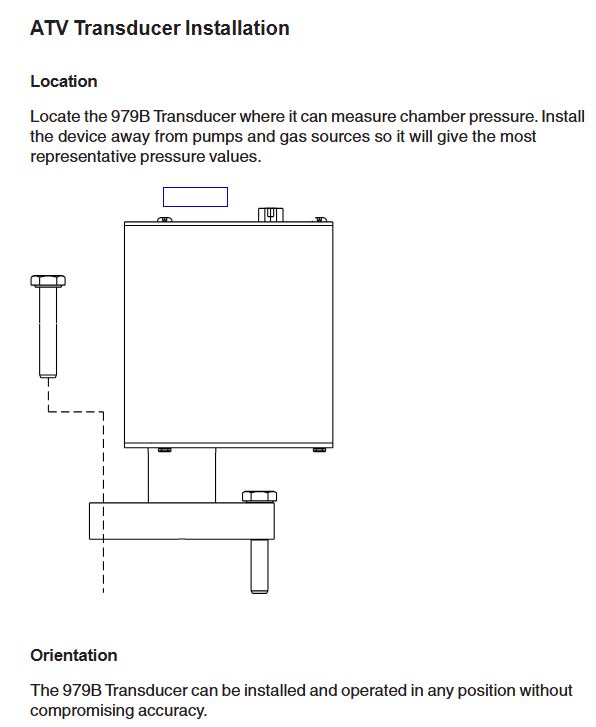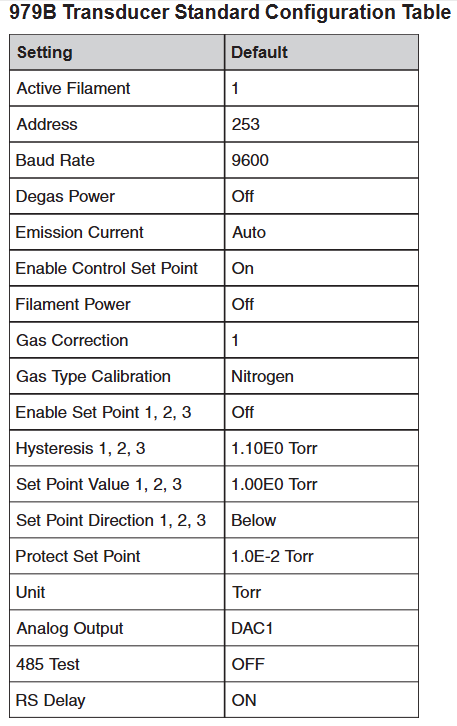MKS 979B Atmosphere to Vacuum Transducer
MKS 979B Atmosphere to Vacuum Transducer
Product basic information
The 979B Transducer is designed to measure vacuum chamber pressures as part of a user’s designed system processes. It combines a Hot Cathode sensor to measure pressures from 5x10 (5 ×10^{-10}) to (3 ×10^{-3}) Torr and a MicroPirani sensor to measure pressures from 1x10 (1 ×10^{-3}) to ATM. PR3 the combined absulute digital pressure output and the analog output provides a single combined reading from 5x10 (5 ×10^{-10}) Torr to ATM. In addition the two sensors can be read independently. Along with an analog output external controls are available for filament select degas so the transducer (often set point values, calibration values ect. have been entered) can operate independently.

Safety and General Specifications
1. Safety warnings and preventive measures
Electrical safety: When replacing sensors or baking, the power supply must be disconnected first (there may be fatal voltage/current), and only qualified technicians can operate electronic components; Use+24 VDC@0.75 Amps power supply, ensure that the sensor is grounded through the vacuum flange and electrical connector rear housing.
Operation restriction: Do not turn on the filament power supply when the system pressure is higher than 5 × 10 ⁻ Torr (which may damage the hot cathode sensor); Prohibited from use in explosive/flammable gas environments (hot cathode heating elements, MicroPirani's nickel film elements may ignite gases); Do not replace parts or modify equipment. Repairs must be sent to the MKS calibration service center.
Pollution protection: prevent dust, metal shavings and other pollutants from entering the equipment; During installation, stay away from electronic/ion sources and strong magnetic fields. If necessary, use a particulate filter (see "Accessories" section for details).
2. General technical specifications
Specific project parameters
Measurement range 5 × 10 ⁻¹⁰ Torr to atmospheric pressure (ATM)
Set point range 5 × 10 ⁻¹⁰ Torr to 100 Torr
Analog output DAC1: 0.5-6.95 VDC (0.5 V/order of magnitude); DAC2: 0.75-10.02 VDC (0.75 V/order of magnitude)
Overvoltage limit of 1500 Torr
Repeatability (typical value) 1 × 10 ⁻⁹ -10 ⁻³ Torr: ± 5% reading; 10 ⁻ -100 Torr: ± 2% reading
Accuracy (typical value) 10 ⁻⁹ -10 ⁻³ Torr: ± 20% reading; 10 ⁻ -100 Torr: ± 5% reading
Supply voltage 24 VDC ± 10%
Power consumption 15 Watts
Rated value of relay contacts 1A@30 VAC/VDC (resistive load), compliant with Semi 52/UL991 safety standards
Vacuum contact material 304 stainless steel, silicon, SiO ₂, SiN ₄, gold, fluororubber (Viton) ®)、 Glass, tungsten, platinum molybdenum plating, yttrium oxide coated iridium, epoxy resin, Kovar alloy
Shell material aluminum/304 stainless steel
Internal volume 23 cm ³
Working temperature 0-40 ℃
Baking temperature (non working state) 85 ℃
Installation direction in any direction
EU certification complies with EMC Directive 89/336/EEC (EN-61326-1) and Low Voltage Directive 73/23/EEC (EN-61010-1)
Vacuum connection methods Mini CF, 2.75 "CF, NW16 KF, NW25 KF, NW40 KF
Size (with KF25) 74 × 79.6 × 100 mm (2.9 "× 3.1" × 3.9 ")
Weight (with KF25) 422 g (0.93 lbs.)

Installation Guide
1. Installation position and direction
Location selection: It is necessary to be able to accurately measure the pressure in the vacuum chamber, away from the pump and gas source to ensure representative readings; Avoid installing directly above the evaporation source (steam may contaminate the sensor), and shield and stay away from strong magnetic fields when approaching electronic/ion sources.
Installation direction: Supports installation in any direction, it is recommended that the vacuum port face downwards (to prevent particles/liquids from entering), which does not affect measurement accuracy.
2. Vacuum connection
The sensor offers multiple flange types: 2.75 "CF (rotatable), 1.33" CF (rotatable) KF16、KF25、KF40, Corresponding flanges need to be matched according to the system, and the manual provides dimension drawings of each flange for reference.
3. Electrical connection
Cable requirements: Use a 15 pin high-density D-sub female cable with strain relief; To meet the anti-interference requirements of EN61326-1, braided shielded cables are required, with metal hooks connected at both ends of the shielding layer and the power supply grounded.
Pin function: The 15 pin D-sub connector has clear pin division, and the core pins include: 1 pin (RS485-/RS232 TXD), 2 pins (RS485+/RS232 RXD), 3 pins (power+24V), 4 pins (power -), 5 pins (analog output+), 6 pins (analog output -), 9 pins (degassing state), 10 pins (filament selection), 13 pins (degassing on), as well as the common terminals (7, 11, 14 pins) and normal terminals (8, 12, 15 pins) of 3 relays. For details, please refer to the "979B Sensor Electrical Connection Table".
Attention: The negative terminal (6-pin) of the analog output should not be connected to the negative terminal (4-pin) of the power supply or other grounding points (which may cause current diversion and measurement errors, and the longer the cable, the greater the error); When connecting inductive loads (such as solenoids and transformers), an arc extinguishing network (resistor R and capacitor C) needs to be installed. The calculation formula is
- EMERSON
- Honeywell
- CTI
- Rolls-Royce
- General Electric
- Woodward
- Yaskawa
- xYCOM
- Motorola
- Siemens
- Rockwell
- ABB
- B&R
- HIMA
- Construction site
- electricity
- Automobile market
- PLC
- DCS
- Motor drivers
- VSD
- Implications
- cement
- CO2
- CEM
- methane
- Artificial intelligence
- Titanic
- Solar energy
- Hydrogen fuel cell
- Hydrogen and fuel cells
- Hydrogen and oxygen fuel cells
- tyre
- Chemical fiber
- dynamo
- corpuscle
- Pulp and paper
- printing
- fossil
- FANUC
- Food and beverage
- Life science
- Sewage treatment
- Personal care
- electricity
- boats
- infrastructure
- Automobile industry
- metallurgy
- Nuclear power generation
- Geothermal power generation
- Water and wastewater
- Infrastructure construction
- Mine hazard
- steel
- papermaking
- Natural gas industry
- Infrastructure construction
- Power and energy
- Rubber and plastic
- Renewable energy
- pharmacy
- mining
- Plastic industry
- Schneider
- Kongsberg
- NI
- Wind energy
- International petroleum
- International new energy network
- gas
- WATLOW
- ProSoft
- SEW
- wind
- ADVANCED
- Reliance
- YOKOGAWA
- TRICONEX
- FOXBORO
- METSO
- MAN
- Advantest
- ADVANCED
- ALSTOM
- Control Wave
- AB
- AMAT
- STUDER
- KONGSBERG
- MOTOROLA
- DANAHER MOTION
- Bently
- Galil
- EATON
- MOLEX
- Triconex
- DEIF
- B&W
- ZYGO
- Aerotech
- DANFOSS
- KOLLMORGEN
- Beijer
- Endress+Hauser
- MOOG
- KB
- Moxa
- Rexroth
- YAMAHA
- Johnson
- Westinghouse
- WAGO
- TOSHIBA
- TEKTRONIX


Email:wang@kongjiangauto.com



































































































































